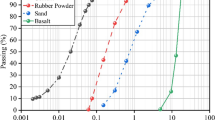Abstract
Experimental investigation was conducted to characterize the responses of pseudo-ductile cementitious composites (PDCCs) when subjected to uniaxial and biaxial compression. The PDCCs is a class of fiber reinforced cementitious composites with ultra-high ductility by using a low volume fraction (2%) of polyvinyl alcohol (PVA) fiber. Two different strength grades of PDCC were examined with cubic specimen size of 100 mm in the tests. The specimens were loaded with a servo-hydraulic jack at different stress ratios. The principle stresses and strains of the specimens were recorded, and the failure modes with various stress states were examined. The test results indicated that the ultimate strength of PDCCs increased due to the lateral confinement in the other principal stress direction, and the maximum ultimate strength occurred at the biaxial stress ratio of 0.25, which was very different from common concrete material. For the PDCC specimens, the biaxial strength may be lower than the uniaxial strength when subjected to biaxial compression with the stress ratio of 1.0, and the failure mode showed a shear-type failure because of the bridging effect of fibers. Finally, a failure criterion was proposed for PDCCs under biaxial compression.
Similar content being viewed by others
References
Li V C, Leung C K Y. Steady state and multiple cracking of short random fiber composites. J Eng Mech ASCE, 1992, 188(11): 2246–2264
Li V C, Mishra D K, Wu H C. Matrix design for pseudo strainhardening fiber reinforced cementitious composites. J Mater Struct, 1995, 28(183): 586–595
Chan Y W, Li V C. Age effect on the characteristics of fiber/cement interfacial bond. J Mater Sci, 1997, 32(19): 5287–5292
Li V C, Wang S, Wu C. Tensile strain-hardening behavior of PVAPDCC. ACI Mater J, 2001, 98(6): 483–492
Maalej M, Li V C. Flexural/tensile strength ratio in engineered cementitious composites. J Mater Civ Eng ASCE, 1994, 6(4): 513–528
Maalej M, Hashida T, Li V C. Effect of fiber volume fraction on the Off-Crack plane energy in strain-hardening engineered cementitious composites. J Am Ceram Soc, 1995, 78(12): 3369–3375
Fukuyama H, Matsuzaki Y, Nakano K, et al. Structural performance of beam elements with PVA-PDCC. In: Proceedings of High Performance Fiber Reinforced Cement Composites 3 (HPFRCC 3), 1999, 531–542
Fischer G, Li V C. Influence of matrix ductility on the tension-stiffening behavior of steel reinforced engineered cementitious composites (PDCC). ACI J Struct, 2002, 99(1): 104–111
Kittinun S, Sherif E T, Gustavo P M. Behavior of high performance fiber reinforce cement composites under multi-axial compressive loading. Cem Concr Com, 2010, 3232: 62–72
Li Y, Liang X W, Liu Z J. Behavior of high performance PVA fiber reinforced cement composites in triaxial compression. J Wuhan Univ Tech, 2010, 32(17): 179–185
Swanepoel W. The Behaviour of Fibre Reinforced Concrete (SHCC) under Biaxial Compression and Tension. Dissertation of Doctoral Degree. South Africa: University of Stellenbosch, 2011
Lan S R, Guo Z H. Experimental investigation of multiaxial compressive strength of concrete under different stress paths. ACI Mater J, 1997, 94(5): 427–434
Kupfer H B, Hilsdorf H K, Rüsch H. Behavior of concrete under biaxial stresses. ACI J, 1969, 66(8): 656–666
Kupfer H B, Gerstle K H. Behavior of concrete under multiaxial stress states. J Eng Mech Div, 1980, 106(6): 1383–1403
Wang H L, Song Y P. Biaxial compression behaviour of different aggregate graded concrete. Mag Concr Res, 2009, 61(6): 457–463
Hampel T. Experimental Analysis of the Behaviour of High Performance Concrete under Multiaxial States of Stress. Dissertation of Doctoral Degree. Germany: TU Dresden, 2006
Xu S L, Cai X R. Experimental study and theoretical models on compressive properties of ultra high toughness cementitious composites. J Mater Civ Eng ASCE, 2010, 22(10): 1067–1077
Hussein A, Marzouk H. Behavior of high-strength concrete under biaxial stresses. ACI Mater J, 2000, 97(4): 27–36
Author information
Authors and Affiliations
Corresponding author
Rights and permissions
About this article
Cite this article
Zhou, J., Pan, J., Leung, C.K.Y. et al. Experimental study on mechanical behaviors of pseudo-ductile cementitious composites under biaxial compression. Sci. China Technol. Sci. 56, 963–969 (2013). https://doi.org/10.1007/s11431-013-5174-9
Received:
Accepted:
Published:
Issue Date:
DOI: https://doi.org/10.1007/s11431-013-5174-9



